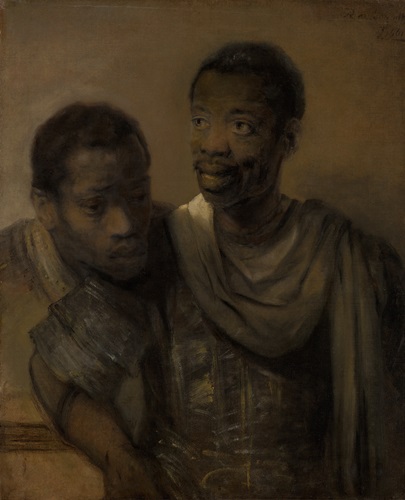Welcome to DU!
The truly grassroots left-of-center political community where regular people, not algorithms, drive the discussions and set the standards.
Join the community:
Create a free account
Support DU (and get rid of ads!):
Become a Star Member
Latest Breaking News
Editorials & Other Articles
General Discussion
The DU Lounge
All Forums
Issue Forums
Culture Forums
Alliance Forums
Region Forums
Support Forums
Help & Search
World History
Related: About this forumRembrandt, Dutch Slave Trade On 4 Continents: New Exhibit, Rijksmuseum, Amsterdam

- Rembrandt’s portraits of sugar-rich couple Marten Soolmans and Oopjen Coppit.
_______________
'Rembrandt and slavery: did the great painter have links to this abhorrent trade?' By Jonathan Jones, The Guardian, Feb. 9, 2021.
No artist is more celebrated for their compassion and empathy. So why has the Dutch master’s work been included in a shocking new show linking art and the slave trade? The title of the show is simple and stark: Slavery. Due to open this spring at the mighty Rijksmuseum in Amsterdam, this bold exhibition documents the importance of this abhorrent trade in the rise and wealth of the Netherlands, by juxtaposing shackles and slave inventories with works of art. There is a metal ring that has been in the Rijksmuseum since the 19th century. Previously catalogued as a dog collar, it is now thought to have been used on a human. There are other similarly chilling exhibits in this disturbing show – and at the heart of them all hang two renowned paintings by Rembrandt.
Their inclusion is shocking. After all, there is no artist more overflowing with compassion and empathy than Rembrandt. Yet this exhibition at the Rijksmuseum, home to so many of his masterpieces, reveals a side of the painter’s career that sits badly with our view of him as an artist with an expansive vision of what it means to be human. In 1634, when he was a 28-year-old art star reeling in commissions by the herring barrel from the Amsterdam elite, Rembrandt van Rijn, the miller’s son from Leiden with a taste for the finer things in life, portrayed a young couple called Marten Soolmans and Oopjen Coppit. The works – they were given a portrait each – are usually seen as yet another example of the genius of Rembrandt, this most all-seeing of artists whose insight raises portraiture to an existential level.
His paintings of married people are often informal moments of shared fun. But to portray this wealthy pair, he posed them apart for separate full-length canvases that have much in common with the show-off portraits Anthony van Dyck was doing in England. Both wear the sombre black of a Protestant republic, but this nod to morality is undermined by adornments signifying their bountiful wealth. Soolmans has glittering, crinkly silk stockings and enormous silvery flounces on his shoes, while Coppit flaunts pearls at her throat and gold on her wrists. Forget their pasty faces, Rembrandt seems to be saying, get a load of the bling. But there’s a deeply troubling side to this couple’s wealth – and Rembrandt may have wanted us to register that there was something amiss. Soolmans was heir to one of Amsterdam’s biggest sugar refineries, and the production of sugar at its origin point depended on slaves.
From the 15th century up to the 1800s, Europe’s sweet tooth was fed by the captivity, transportation and brutal exploitation of Africans on sugar plantations in the Americas and Caribbean. The “golden age” of the Dutch Republic – when Amsterdam was the world’s busiest entrepôt and Dutch merchant ships traversed the world – saw the Netherlands muscling in on Iberian dominance in both sugar and slavery. The Rijksmuseum is stuffed with the artistic riches of the 17th-century Netherlands. For it to draw attention to the links between art, wealth and inhumanity in that age is a bold move. But it is time “to come clean”, Valika Smeulders, the museum’s head of history, told me – in order to “connect the collection to that history”. Parallel to the show, the Rijksmuseum has added labels to 80 objects in its collections that have links to slavery...
More,
https://www.theguardian.com/artanddesign/2021/feb/09/rembrandt-slavery-slave-trade-marten-soolmans-oopjen-coppit
______________
Also, Rijksmuseum Reveals Details of Groundbreaking Slavery Exhibit, Dutch News, Dec. 2020,
https://www.dutchnews.nl/news/2020/12/rijksmuseum-reveals-details-of-ground-breaking-slavery-exhibition/

- Shackles used for chaining multiple enslaved people.
Related, Dutch's Golden Age Included Others Than Just White Subjects, June 2020,
https://suzannelovellinc.com/blog/dutchs-golden-age-included-others-than-just-white-subjects/

- A portrait by Jasper Beckx of Don Miguel de Castro, 1643. The painting is on loan from Statens Museum for Kunst in Copenhagen. Image courtesy of: The New York Times
Related, Black Portraits of The Dutch Golden Age, NYT, March 2020,
https://www.nytimes.com/2020/03/13/arts/design/black-portraits-dutch-golden-age.html

- “King Casper” by Hendrik Heerschop, 1684. Image courtesy of: Dutch News

- 'Two African Men' by Rembrandt, 1661, possibly unfinished. Courtesy Mauritshuis Museum.

- “Johan de la Faille,” by Jan Verkolje, 1674. Oil on copper. Image courtesy of: WBUR